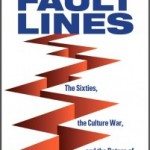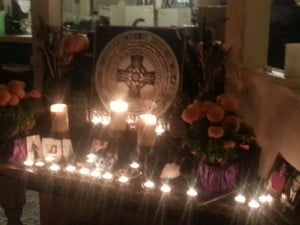I was recently involved in an intense discussion arising over an article linked from The Wild Hunt. The article complained about a friend’s statement describing Paganism to an interfaith audience, and I responded by defending him. After that the discussion took off in the direction of “Who is a Pagan and how do we know?” I continued until, in my judgment, we were getting too testy. Best to stop.
But most of the issues discussed were important.
Afterwards I realized I had accumulated what could become an article of its own on the meaning of Pagan religion. As I reworked it, I was led to explore issues I had not touched on that now seem relevant, ranging from “Who cares?” to “Does the Pagan religious tradition look backwards or forwards?”
Before I get started, a word of caution. Religions are notoriously difficult to label, both as to their practices and their spiritual beliefs. Consider Christianity, which agrees on the ultimate authority of a single text. In 2000 years of devoted study, there has never been agreement as to what this text really means. And not just on minor issues.
What was Jesus’ true nature? What is the nature of our fall, from which we need salvation? How do we obtain salvation? Some Christians are extreme transcendentalists. Others are panentheists. Some are mystics, and others deeply distrust mysticism. Some believe you can directly access the Holy Spirit, others that such apparent access is demonic deception. All point to the Bible to justify their views. This is why I argued earlier on Patheos that no concept of monotheism about which monotheists agree amounts to more than a slogan.
And yet, when people say they are Christians, they are not speaking incoherently. While the details of key concepts like Jesus and salvation and God will differ among them, they exist within a common pattern. The agreement might be thin, but it is there: a story about a divine being whose innocent death enabled God to forgive the sins of everyone if they believed in him. Despite many deep disagreements Christians rarely argue other Christians are Muslims or Jews or Buddhists. The same is true for Muslims, Jews, and Buddhists. All are identified by different stories about how human beings should relate to what is ultimate.
If I am right, we can ask a similar question about our own religion, to try and see if we can make sense of the bewildering diversity of traditions and practices which identify, or are identified, as Pagan. I think such a story exists.
But first I want to begin with the most fundamental question…
Who Cares?
Most of the time, I don’t. What my coven does is fulfilling to me and to us, and we do not much care what others are or are not doing on full moons or other sacred days. Of course, it feels good that many others are also celebrating the moon, but we never wonder whether they are doing it ‘right’. Modern Paganism is primarily a religion of personal and small group communion with (and sometimes intimate contact with) our Gods. We are not a religion of big organizations and mega-congregations. Large public celebrations do occur, usually on major Sabbats, but there is no effort by organizers of these gatherings to institutionalize them into a ‘Pagan’ church. We gather, celebrate together, and disperse, rarely thinking about questions of identity.
We are not a religion of dogma. There is a Wiccan rede and doubtless similar things can be found within some other traditions, but there is no Pagan rede, and even the Wiccan rede reads differently from different sources. When someone tells me she or he is a Pagan, I do not wonder whether they have the right beliefs. Are they pantheists or panentheists? Are they the right kind of polytheist? Are their deities “aspects” of more encompassing deities, treated as entirely distinct, or perhaps thought of as Jungian archetypes? I think I am on almost universally accepted ground when I say that A Course in Miracles is not Pagan, while Stewart Farrar’s What Witches Do is. Interestingly, we can all agree about this without agreeing about the details of our personal Pagan practice, even if we are coven mates. At the level of our personal and group practice, what is or is not Pagan is not important.
If you have one, your tradition is what is important. Gardnerian, Druidic, Heathen, CAW, NROOGD, Feraferia, Reclaiming, Asatru, Romuva, Voudon, and many others are all Pagan traditions with sets of specific practices their adherents are supposed to know. This enables a quality of group observance that can only happen when people agree on the forms. But the broader term “Pagan” is not helpful here.
This leads to my first point:
Defining “Pagan” is almost always only important in more-than-Pagan contexts. Definitions are useful in interfaith settings when a Christian, Muslim, or Buddhist asks how Pagan religion is different from and similar to their own. Scholars and scientists like definitions because definitions help them think clearly about something and its relation to other things. When someone gets interested in “Paganism” and wants to learn more, it helps if there is some sense of what the word means to give them some initial direction. When Wiccans or Asatru or Druids or Romuva wonder how their practice relates to the broader world of human spiritual experience and religious observance, the term “Pagan” also has some heavy lifting to do.
A philosopher, theologian, or serious student’s questions will usually be different from those asked by a person we meet in a coffee house. The coffee drinker wants to know what we are, more or less, and the scholars, scientists, and students want to know not only that, but also how “Pagan” fits into larger categories of understanding. I want to suggest we usually give two general kinds of definitions, one as a kind of story, the other describing the logic we perceive within the story.
Spirituality and Religion
One other basic point needs to be made explicit before my argument can be understood: the difference between spirituality and religion. As I use these terms, “religion” is something rooted in what we do together. Religion is a community endeavor. “Spirituality” is our personal sense of relationship to the sacred. It can be identical to our religion, but it can also be far more complex and paradoxical than any viable religion could be. Let me explain.
People in very different societies report having spiritual experiences that defy being put into words. Religions are necessarily rooted in words, or in rituals made possible by our communicating in words. Therefore, personal spiritualities can have depths of meaning that are not a part of any particular religion, but are very important to the individual. If asked about them, a person might make contradictory statements, because what they are getting at is more basic than the words with which they try to describe it. At the level of language spirituality can appear contradictory, but it may not be felt that way by the individual.
Access to religion is through words because we are social beings and we do religion together. Important aspects of our personal spirituality may not be amenable to this approach, and so remain private. Or we might devise a ritual in which we each give different meanings to what we do together. The ritual is religious, but its meaning for those engaged in the ritual may be spiritual.
The Importance of Stories
In religion, we try and make collective sense of what we do. In doing so, the basic story that shapes a religion comes into being. A story is not a theory, not a doctrine, not a philosophy or theology. Story telling is a primordial means for making sense of the world that we experience together. Stories are narratives with fuzzy edges, and a religious narrative is one in which we who practice that religion feel at home. Those fuzzy edges are essential to a story’s success because they help us integrate what we can agree on together with what we experience personally. The fuzzy edges are an important part of where community religion and individual spirituality meet.
I think all religions can be organized depending on the stories they tell. Different kinds of religions tell different kinds of stories, although all are concerned with how we can best relate with the More-Than-Human, the ultimate context of existence. But what the nature of that context is, what kinds of relationships might we have with it, and how we can act most appropriately varies between religions in ways that relate to each religion’s basic story.
I think, in religion, that stories come first, and definitions arise out of people trying to look behind the story to see more abstractly what is ‘really’ happening.
Think of the basic story behind Christianity. People are cut off from God through sin and are incapable of bridging the distance on their own. God’s innocent son is then born in human form to live amongst us. He is killed, and in that killing, a sacrifice is made that enables all who believe in him to have that distance bridged, and so be forgiven. Put very abstractly, there is a problem regarding our relation to the Ultimate, a solution is sent to solve the problem, and the problem is solved.
Christian theology arises from people trying to figure out what is behind this story, what it really means. They agree about the story, and they have never agreed about the theology, but the theologies always seek to shed light on the story.
Pagan religion can also be put into a simple story. The world is sacred and consists of many levels of reality, from the purely physical to the (in our terms) immaterial. We live in this world as material beings who often get out of harmony with its guiding principles. We can interact in some ways with other elements of this spiritual reality. Wise spirits provide means by which people as individuals and as a human community can re-establish or strengthen their living in harmony within this spiritual community.
Put abstractly enough, Paganism and Christianity address the same problem: we are out of harmony with basic reality and suffer as a result. These religions offer ways to heal that division and so bring about a better situation. But we need get only a little into the details for important differences to appear. The Christian story deals with how each individual person can win salvation ultimately on their own, with or without the help of a church. The penalty for failure is horrendous. In the Christian understanding, we all share a common problem, but we are ultimately each on our own in solving it, and we are playing for the highest imaginable stakes. The Pagan story emphasizes that we are inextricably part of a sacred community that includes both the material world and the spiritual realms. Our relationships within that community are more important than our relationship with what is Ultimate. We are not ultimately isolated from the world. While concepts like love can help Pagan and Christian stories overlap for some people, their differences are fundamental.
The Pagan story tells us that Stewart Farrar’s What Witches Do fits the narrative and A Course of Miracles does not. I must emphasize this does not mean A Course of Miracles is necessarily inferior to What Witches Do, only that it is a part of a different story.
This basic story, with some embellishments, is likely what most of us tell that interested person at the coffee house who asks us what Pagans believe. We will likely elaborate only if further questions come our way. Further, in both Pagan and Christian communities, probably all most people want to know is their religion’s story and how it can guide them and help make sense of their lives. I think this is absolutely fine. I do not think it is important for Pagans in general to read and understand various approaches to Pagan theology. (And I love this topic.) While falling far short of a theology, in a way this essay attempts to demonstrate—even to those of us who enjoy philosophical and spiritual speculation—that the quality of our relationships within community is more important than whether we understand particular theological issues.
Still, descriptions that go further than the basic story are useful in many contexts, and very useful in some. Good definitions clarify thinking and reduce errors; poor ones make coherent thinking difficult and increase the likelihood of errors, some of them serious. What does the story mean? What view of what is ultimate makes the Pagan story different from the Christian story? Can they be combined?
For those of us who like this kind of thing, Part II will begin to illuminate a deeper understanding of Pagan religion. Part II will be titled “A Spiritual Taxonomy.”
















